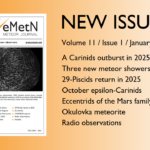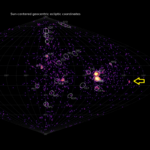Abstract: The meteor activity of the April-Lyrids and the eta-Aquariids were observed by radio meteor observers worldwide. The April-Lyrids showed a peak time later than in previous years. The eta-Aquariids displayed the same usual activity level as in previous years.
1. Introduction
Radio Meteor Observations in the world covered the meteor shower activity of the April-Lyrids and the eta-Aquariids 2020. Worldwide radio meteor observation data were provided by Radio Meteor Observation (RMOB) (Steyaert, 1993) and by the radio meteor observations network in Japan (Ogawa et al., 2001).
2. Method
For analyzing worldwide radio meteor observation data, meteor activities are calculated by the “Activity Level” index (Ogawa et al., 2001). The activity profile was estimated by the Lorentz activity profile (Jenniskens, 2000).
3. Results
3.1. April-Lyrids
Figure 1 shows the result for the April-Lyrids with 37 observations in 14 countries. The activity peak was estimated to occur around 12h UT on 22nd of April (Solar Longitude λʘ = 32.5°). Distinct activity was seen from 12h on 21st to 12h 23rd UT. The time of the maximum peak occurred later than in previous years. The long-term activity profile for the April-Lyrids for 2007–2020 is shown in Figure 2. The peak in the long-term activity is at Solar Longitude λʘ = 32.2° with full width half maximum (FWHM) –0.4° / +0.6°. The maximum activity level was 0.6. This is the same as in the long-term activity level.

Figure 1 – April-Lyrids 2020 using worldwide radio meteor observations.

Figure 2 – The long-term activity profile of the April-Lyrids covering the period 2007–2020.
More April-Lyrids results and information are provided on website (http://www.amro-net.jp/meteor-results/04_lyrids.htm ).
3.2. eta-Aquariids
One of the major meteor showers, the eta-Aquariids displayed the same activity level compared with previous years. The peak time was estimated to have occurred around 20h UT, 5th May (Solar Longitude λʘ = 45.52°) with a maximum activity level = 1.1 in 2020. Ogawa and Steyaert (2017) provided the annual activity profiles, peak solar longitude λʘ = 45.1° with FWHM = –1.7° / +4.7°. The maximum activity level was 1.0.
Figure 3 provides two graphs, the 2020 result compared with the long-term previous years. The red line in the graph represents the long-term activity covering the period 2004–2019.

Figure 3 – eta-Aquariids 2020 compared with the long-term activity profile.
More eta-Aquariids results and information are provided on website (http://www.amro-net.jp/meteor-results/05_aqreta.htm ).
Acknowledgment
The April Lyrids and eta-Aquariids data were provided by the following observers:
Philip Norton (UK), Phil Rourke (UK), Felix Verbelen (Belgium), test josephco_@_Graves (Belgium), Chris Steyaert (Belgium), Jochen Richert_1 (Switzerland), Associazione Pontina di Astronomia _APA (Italy), Mario Bombardini (Italy), Oss_Monte_San_Lorenzo DLF (Italy), GAML Osservatorio_Astronomico_Gorga (Italy), Fabio Moschini_IN3GOO (Italy), AAV Planetario_di_Venezia (Italy), Per DL0SHF (Germany), Fred Espey (Germany), WHS Essen (Germany), Jean Marie F5CMQ (France), DanielD SAT01_DD (France), Jacques Molne (France), Kees Meteor (Netherlands), La Salle Radio_Club (Spain), Roman S58P (Slovenia), Stan Nelson (USA), Eric Smestad_KC0RDD (USA), ARS KF3BH_FN11ta (USA), Mike Otte (USA), Bob Mobile_K1SIX (USA), Salvador Aguirre (Mexico), Andrew Klekociuk (Australia), Halei Test (China), Kenji Fujito (Japan), M.Tsuboi (Japan), Hirofumi Sugimoto (Japan), Hirotaka Otsuka (Japan), Kazuyoshi Kanatsu (Japan).
Worldwide data were provided by Radio Meteor Observation Bulletin (RMOB) (http://www.rmob.org/).
References
Jenniskens P., Crawford C., Butow S. J., Nugent D., Koop M., Holman D., Houston J., Jobse K., Kronk G., and Beatty K. (2000). “Lorentz shaped comet dust trail cross section from new hybrid visual and video meteor counting technique imprications for future Leonid storm encounters”. Earth, Moon and Planets, 82–83, 191–208.
Ogawa H., Toyomasu S., Ohnishi K., and Maegawa K. (2001). “The Global Monitor of Meteor Streams by Radio Meteor Observation all over the world”. In, Warmbein, Barbara, editor, Proceeding of the Meteoroids 2001 Conference, 6–10 August 2001, Swedish Institute of Space Physics, Kiruna, Sweden. ESA Publications Division, European Space Agency, Noordwijk, The Netherlands, pages 189–191.
Ogawa H., Steyaert C. (2017). “Major and Daytime Meteor Showers using Global Radio Meteor Observations covering the period 2001-2016”. WGN, Journal of the IMO, 45, 98–106.



